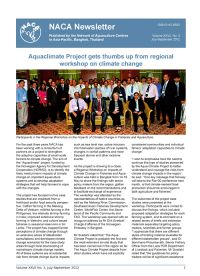In this issue:
Aquaculture in Hubei Province, central China. Ornamental fish farming - a successful cottage industry in rural and urban India. Measuring empowerment of women through self-help groups in aquaculture. Pigeon pea Cajanus cajan cultivation over fish pond dykes - an economically viable farming approach. Culture of freshwater climbing perch Anabas testudineus. Augmentation of fish production from a small reservoir of Vidarbha: A success story. Emergency consultation on early mortality syndrome of shrimp.
In this issue:
Aquaclimate Project gets thumbs up from regional workshop on climate change. Developing climate resilient aquaculture: The Aquaclimate Project. Regional framework for cooperation on climate change. Emergency regional consultation on shrimp early mortality syndrome, 9-10 August, Bangkok. Regional study/workshop on adoption of aquaculture assessment tools for sustainability. Regional proficiency testing for aquatic animal disease diagnostic laboratories.
Nopadol Phuwapanish presents the 2012 research and development progress report of the NACA Regional Lead Centre, Thailand.
Joebert Toledo presents the 2012 research and development report for the NACA Regional Lead Centre, Philippines.
Min Kuanhong presents the 2012 research and development report for the NACA Regional Lead Centre, China.

